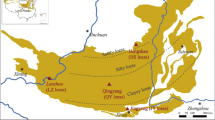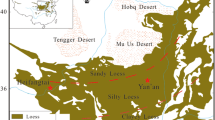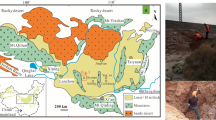Abstract
Multiple consolidation-permeability tests were performed on loess samples from the South Jingyang Plateau in northwest China to analyze permeability under actual stresses. Three-dimensional microstructures for loess samples under each consolidation stress were established based on high-resolution computed tomography images to thoroughly interpret the permeability variation in terms of the loess microstructures including the pores and throats. With increasing consolidation pressure, the permeability decreased greatly at the beginning and tended to become stable. In the stage of dramatic decrease in permeability, pore coordination number decreased slightly under pressure, indicating little influence of connectivity among pores on permeability. The pores in the range of 14 to 25 μm decreased by 10.1% in volume percentage, and the pores larger than 13 μm decreased by 19.6% in number. Accordingly, throats larger than 6 μm decreased by 13.1% in area percentage, and throats larger than 2 μm decreased by 14.9% in number. Throat size distribution played a decisive role in permeability, pore size distribution acted as a bridge to influence permeability, and only the spaced pores and some interaggregate or intergrain pores larger than 13 μm that allowed free water to pass were related to permeability. The decreases in these relatively large pores and throats caused considerable decreases in permeability. However, the existence of large throats, even large numbers of such throats, does not mean high permeability, which can be verified in the stable stage of permeability. This research provides a better understanding of loess permeability in terms of three-dimensional microstructure and further insights into the stability analysis of loess slopes and the control of other hazards in loess regions.



















Similar content being viewed by others
References
Assallay AM, Jefferson I, Rogers CDF, Smalley IJ (1998) Fragipan formation in loess soils: development of the Bryant hydroconsolidation hypothesis. Geoderma 83(1–2):1–16
ASTM (2006) Annual book of ASTM standards. ASTM International, West Conshohocken, Pa
Deng LS, Fan W, Yin YP, Cao YB (2018a) Case study of collapse investigation for loess sites covered by very thick loess-paleosol interbedded strata. Int J Geomech 18(11):05018009
Deng LS, Fan W, Yu MH (2018b) Parametric study of a loess slope based on unified strength theory. Eng Geol 233:98–110
Dibben SC, Jefferson IF, Smalley IJ (1998) The "Loughborough loess" Monte Carlo model of soil structure. Comput Geosci 24(4):345–352
Elhakim AF (2016) Estimation of soil permeability. Alexandria Engineering Journal 55(3):2631–2638
Fan W, Deng LS, Yuan WN (2018) Double parameter binary-medium model of fissured loess. Eng Geol 236:22–28
Gibbs HJ, Holland WY (1960) Petrographic and engineering properties of loess. Bureau of Reclamation, US Department of the Interior, Denver, Colo
Hong BN, Liu X (2010) Theoretical and experimental reseach on soil microstructure. Science Press, Bei jing (in Chinese)
Houston AN, Otten W, Falconer R, Monga O, Baveye PC, Hapca SM (2017) Quantification of the pore size distribution of soils: assessment of existing software using tomographic and synthetic 3D images. Geoderma 299:73–82
Hu RL, Yeung MR, Lee CF, Wang SJ (2001) Mechanical behavior and microstructural variation of loess under dynamic compaction. Eng Geol 59(3–4):203–217
Hu R, Chen YF, Liu HH, Zhou CB (2013) A water retention curve and unsaturated hydraulic conductivity model for deformable soils: consideration of the change in pore-size distribution. Géotechnique 63(16):1389–1405
Jiang MJ, Hu HJ, Liu F (2012) Summary of collapsible behaviour of artificially structured loess in oedometer and triaxial wetting tests. Can Geotech J 49(10):1147–1157
Jiang MJ, Zhang FG, Hu HJ, Cui YJ, Peng JB (2014) Structural characterization of natural loess and remolded loess under triaxial tests. Eng Geol 181:249–260
Kuncoro PH, Koga K, Satta N, Muto Y (2014) A study on the effect of compaction on transport properties of soil gas and water I: relative gas diffusivity, air permeability, and saturated hydraulic conductivity. Soil Tillage Res 143:172–179
Lapierre C, Leroueil S, Locat J (1990) Mercury intrusion and permeability of Louiseville clay. Can Geotech J 27(6):761–773
Lei XY (1987) Size of loess pores in relation to collapsibility. Hydrogeology & Engineering Geology 5:15–18 (In Chinese)
Li YF (1991) Relationship between the permeability and the porosity of Luochuan's loess layer. Journal of Xi'an College of Geology 13(2):60–64 (in Chinese)
Li PY, Qian H (2013) Global curve-fitting for determining the hydrogeological parameters of leaky confined aquifers by transient flow pumping test. Arab J Geosci 6(8):2745–2753
Li WC, Lee LM, Cai H, Li HJ, Dai FC, Wang ML (2013) Combined roles of saturated permeability and rainfall characteristics on surficial failure of homogeneous soil slope. Eng Geol 153:105–113
Li PY, Qian H, Wu JH (2014) Comparison of three methods of hydrogeological parameter estimation in leaky aquifers using transient flow pumping tests. Hydrol Process 28(4):2293–2301
Li P, Li TL, Vanapalli SK (2016) Influence of environmental factors on the wetting front depth: a case study in the loess plateau. Eng Geol 214:1–10
Li YR, He SD, Deng XH, Xu YX (2018) Characterization of macropore structure of Malan loess in NW China based on 3D pipe models constructed by using computed tomography technology. J Asian Earth Sci 154:271–279
Liang CY, Cao CS, Wu SR (2018) Hydraulic-mechanical properties of loess and its behavior when subjected to infiltration-induced wetting. Bull Eng Geol Environ 77(1):385–397
Lin XY, Li TL, Zhao JF, Wang H, Li P (2014) Permeability characteristics of loess under different consolidation pressures in the Heifangtai platform. Hydrogeology & Engineering Geology 41(1):41–47 (in Chinese)
Liu Z, Liu FY, Ma FL, Wang M, Bai XH, Zheng YL, Yin H, Zhang GP (2016) Collapsibility, composition, and microstructure of loess in China. Can Geotech J 53(4):673–686
Mahbub AA, Haque A (2016) X-ray computed tomography imaging of the microstructure of sand particles subjected to high pressure one-dimensional compression. Materials 9(11):890
Muñoz-castelblanco JA, Pereira JM, Delage P, Cui YJ (2012) The water retention properties of a natural unsaturated loess from northern France. Géotechnique 62(2):95–106
Ng CWW, Kaewsong R, Zhou C, Alonso EE (2017) Small strain shear moduli of unsaturated natural and compacted loess. Géotechnique 67(7):646–651
Osawa H, Matsuura S, Matsushi Y, Okamoto T (2017) Seasonal change in permeability of surface soils on a slow-moving landslide in a heavy snow region. Eng Geol 221:1–9
Osipov VI, Sokolov VN (1995) Factors and mechanism of loess collapsibility. In Genesis and properties of collapsible soils. Editor-in-Chief E. Derbyshire. Springer, Dordrecht, pp. 49–63
Peng JB, Wang GH, Wang QY, Zhang FY (2017) Shear wave velocity imaging of landslide debris deposited on an erodible bed and possible movement mechanism for a loess landslide in Jingyang, Xi'an, China. Landslides 14(4):1503–1512
Pusch R, Weston R (2003) Microstructural stability controls the hydraulic conductivity of smectitic buffer clay. Appl Clay Sci 23(1–4):35–41
Qiu HJ, Cui P, Hu S, Regmi AD, Wang XG, Yang DD (2018) Developing empirical relationships to predict loess slide travel distances: a case study on the loess plateau in China. Bull Eng Geol Environ 77(4):1299–1309
Sun P, Peng JB, Chen LW, Lu QZ, Igwe O (2016) An experimental study of the mechanical characteristics of fractured loess in western China. Bull Eng Geol Environ 75(4):1639–1647
Vogel H-J, Roth K (2001) Quantitative morphology and network representation of soil pore structure. Adv Water Resour 24(3–4):233–242
Wang M, Bai XH (2006) Collapse property and microstructure of loess. In: Proceedings of the GeoShanghai international conference 2006. Shanghai, China, pp 111–118
Wang M, Bai XH, Frost JD (2010) Influence of initial water content on the collapsibility of loess. In Proceedings of the GeoShanghai international conference 2010, Shanghai, China, pp. 60–68
Wei YN, Fan W, Cao YB (2017a) Experimental study on the vertical deformation of aquifer soils under conditions of withdrawing and recharging of groundwater in Tongchuan region, China. Hydrogeol J 25(2):297–309
Wei YN, Fan W, Wang W, Deng LS (2017b) Identification of nitrate pollution sources of groundwater and analysis of potential pollution paths in loess regions: a case study in Tongchuan region, China. Environ Earth Sci 76(12):423
Wei TT, Fan W, Yu NY, Wei YN (2019a) Three-dimensional microstructure characterization of loess based on a serial sectioning technique. Eng Geol 261:105265
Wei TT, Fan W, Yuan WN, Wei YN, Yu B (2019b) Three-dimensional pore network characterization of loess and paleosol stratigraphy from south Jingyang plateau, China. Environ Earth Sci 78:333
Wen BP, He L (2012) Influence of lixiviation by irrigation water on residual shear strength of weathered red mudstone in Northwest China: implication for its role in landslides' reactivation. Eng Geol 151:56–63
Wen BP, Yan YJ (2014) Influence of structure on shear characteristics of the unsaturated loess in Lanzhou, China. Eng Geol 168:46–58
Xie C (2016) Study on the permeability and landslide of loess in south Jingyang plateau. Thesis, Chang'an University. (in Chinese)
Xu L, Coop MR (2016) Influence of structure on the behavior of a saturated clayey loess. Can Geotech J 53(6):1026–1037
Xu L, Dai FC, Min H, Kwong AKL (2010) Loess landslide types and topographic features at south Jingyang plateau, China. Earth Science --- Journal of China University of Geosciences 35(1):155–160 (in Chinese)
Xu L, Dai FC, Gong QM, Tham LG, Min H (2012) Irrigation-induced loess flow failure in Heifangtai platform, north-West China. Environ Earth Sci 66(6):1707–1713
Xu L, Dai FC, Tu XB, Javed I, Woodard MJ, Jin YL, Tham LG (2013) Occurrence of landsliding on slopes where flowsliding had previously occurred: an investigation in a loess platform, North-west China. Catena 104:195–209
Yuan WN, Fan W, Jiang CC, Peng XL (2019) Experimental study on the shear behavior of loess and paleosol based on ring shear tests. Eng Geol in press
Zeng RQ, Meng XM, Zhang FY, Wang SY, Cui ZJ, Zhang MS, Zhang Y, Chen G (2016) Characterizing hydrological processes on loess slopes using electrical resistivity tomography - a case study of the Heifangtai terrace, Northwest China. J Hydrol 541:742–753
Zhang DX, Wang GH, Luo CY, Chen J, Zhou YX (2009) A rapid loess flowslide triggered by irrigation in China. Landslides 6(1):55–60
Zhang Y, Hu ZQ, Xue ZJ (2018) A new method of assessing the collapse sensitivity of loess. Bull Eng Geol Environ 77(4):1287–1298
Zhao JB, Long TW, Wang CY, Zhang Y (2012) How the quaternary climatic change affects present hydrogeological system on the Chinese loess plateau: a case study into vertical variation of permeability of the loess - palaeosol sequence. Catena 92:179–185
Zhao B, Wang J, Coop MR, Viggiani G, Jiang M (2015) An investigation of single sand particle fracture using X-ray micro-tomography. Géotechnique 65(8):625–641
Zhao CL, Shao MA, Jia XX, Nasir M, Zhang CC (2016) Using pedotransfer functions to estimate soil hydraulic conductivity in the loess plateau of China. Catena 143:1–6
Zhuang JQ, Peng JB (2014) A coupled slope cutting-a prolonged rainfall-induced loess landslide: a 17 October 2011 case study. Bull Eng Geol Environ 73(4):997–1011
Funding
The authors sincerely acknowledge the financial support from the State Key Program of National Natural Science of China (Grant No. 41630634) and the Fundamental Research Funds for the Central Universities (Grant Nos. 310826175005 and 310826173401).
Author information
Authors and Affiliations
Corresponding author
Rights and permissions
About this article
Cite this article
Wei, Yn., Fan, W., Yu, N. et al. Permeability of loess from the South Jingyang Plateau under different consolidation pressures in terms of the three-dimensional microstructure. Bull Eng Geol Environ 79, 4841–4857 (2020). https://doi.org/10.1007/s10064-020-01875-y
Received:
Accepted:
Published:
Issue Date:
DOI: https://doi.org/10.1007/s10064-020-01875-y




